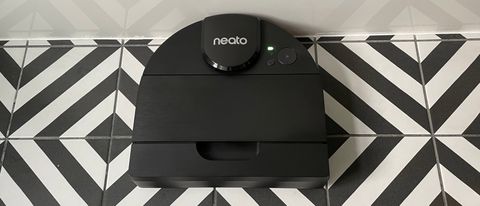TechRadar Verdict
The Neato D9 is the mid-range robot vacuum on offer from this established brand. It can vacuum for up to 200 minutes and cover up to 1600 square feet / 149 square meters before it needs a recharge. It’s dirt collection is good and there’s an accompanying app which will display your floor plan as mapped by the onboard lidar and allow you to draw no-go zones. However, it’s not without its quirks.
Pros
- +
Create no-go zones and schedules in app
- +
Easy to set up
- +
Boost and eco power
Cons
- -
Climbs on to some furniture
- -
No alert when dust bin full
- -
Disappointing corner cleaning
Why you can trust TechRadar
One-minute review
With over ten years of robot vacuum design and manufacture under its belt, US brand Neato Robotics has a reputation for market-leading innovations. As the industry was committed to the round robot vacuum design, Neato was thinking outside the box, trying to develop the best possible robot for all scenarios. This led it to create the D shape robot, with the aim of achieving better dirt collection from corners.
Having recently launched a trio of new robot vacuums, Neato has worked hard to improve upon previous generations. The new range features an improved app as well as better dirt collection than the earlier D3 and D5 vacuums. The Neato D9 is the mid-range model, it features a longer run time and better dirt pick up than the less expensive D8, but for all the top-of-the-range features including the longest run time, the D10 is the model designed for the ultimate clean, but it comes with a high price tag to match.
Like the D8, the D9 features an eco and boost mode, as well as lidar navigation and room mapping. In addition to scheduling cleans and creating no-go zones, the app also allows you to create virtual cleaning zones and manage multiple floor plans.
The D9 has improved pick up in comparison to the D8 as well as a longer 200-minute run time, but this pales in comparison to the 300-minute run time you get from the D10. As you’d expect from a mid-range model the ultra-performance filter isn’t quite as good as the HEPA filter onboard the D10 but it is an improvement on the high-performance filter that comes with the D8.
We’re reviewing the D9 straight after the D8 and it’s safe to say the upgraded features aren’t just on paper. We noticed better dirt pick up on our floors and the robot appeared to navigate in a more logical pattern, missing fewer areas. In general, it seemed a bit more refined than the D8 and would be ideal for most households but be wary if you have delicate furniture as it may try to climb up it.
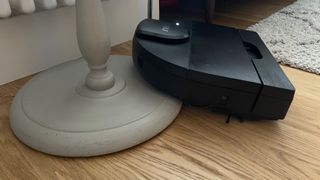
Neato D9 price and availability
- List price: $699.99/ £749.99
The Neato D9 is priced at $699.99/ £749.99 and is available worldwide through Amazon or direct through Neato in the US.
It’s more affordable than the top-of-the range Neato D10 which will set you back $799.99/ £949.99. And it’s pricier than the entry-level D8 which costs $599.99/ £624.93. But for the extra money you get a longer run time, better filter and better dust pick up.
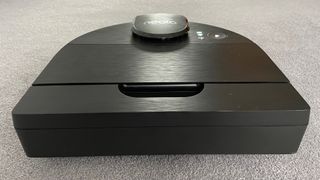
Design
- Iconic D shape design
- 24.6 oz / 0.7-liter dirt bin
- Ultra-performance filter
In contrast to most other round robot vacuums, the D shape design of Neato vacuums makes them instantly recognizable. It also allows space for an 11 inch/ 28cm spiral combo brush (the main brush) which Neato claims is up to 70% wider than other round robots on the market, enabling it to cover the maximum floor space in fewer passes.
The robot measures 3.99 x 13.22 x 12.71 inches/ 10.1 x 33.6 x 32.3cm (h x w x d). And if you’re planning on carrying it between floors, at 8.07 pound s/ 3.7kg it’s not too heavy to lift. The charging dock is neat, compact and easy to move around as we recommend later in this review. It has to be positioned with 30cm/ 1 ft of space all around it to allow the robot to find it easily, but thankfully it’s not too big so won’t dominate a space.
The ultra-performance filter captures 99.5% of allergens and has a mesh surface that makes it easy to clean. The filter can be found in the 24.6 oz/ 0.7 liter dirt bin and has to be removed to empty out the dirt. The bin itself lifts out of the top of the robot and the capacity is an industry-leading size, according to Neato.
On top of the robot, there’s just a play button, so you can start cleaning directly from the robot, but all other features, including suction levels and scheduling, are accessed via the app.
A rotating side brush spins to collect dust and debris from along the side of the rooms and attaches with a magnet for easy replacement. There’s not much else in the box, but you do get two spare filters and a replacement spiral combo brush as well as a brush cleaning tool. The filter needs replacing every one to two months and the spiral combo brush should be replaced every six to eight months.

Performance
- Avoids falling down stairs
- Transitions well between area rugs and hard floor
- Good dirt pick up
The Neato D9 impressed us with good dirt pick up on the majority of the floor. It tackled the vacuuming with a methodical pattern that ensured no areas were missed. Despite the iconic D shape design, corner cleaning was not great, and we’ve seen better corner cleaning from round robots. The issue is partially that the robot starts to turn out of the corner as it approaches it, therefore it doesn’t utilize its shape and reach fully into the corner. Edge cleaning was also patchy at times.
The leading edge is flat and wide, so where some round robots might be able to partially vacuum into a small space before their widest part stops them reaching further, the D shape means this robot leads with its widest edge, so has less chance of even partially reaching into tight spots.
When it gets stuck or trapped, the robot can lift at the back or front to free itself. This feature also means it can easily overcome high door thresholds or a slight unevenness between flooring types. However, this can be problematic at times, causing the robot to attempt to clean areas it shouldn’t. In our testing it tried to clean the base of a floor standing lamp and had a go at climbing up a chair leg as well as onto the frame of a floor standing mirror. It didn’t cause any damage, but this certainly wouldn’t be acceptable if we had antique furniture.
There’s a noticeable gust of air emitted from the rear of the robot as it vacuums, which isn’t a problem if you schedule it to vacuum while you’re out of the house. But if you’re at home on a cold day and it vacuums near you, you’ll definitely notice the cold breeze it creates.
If you plan to use the robot on different floors of your house, take a tip from us and plug in the charging dock on the floor you’re vacuuming, if you start the robot from here it’ll return here at the end. If, like us, you leave the charger on another floor, at the end of cleaning the robot will return to where it started and repeatedly bash into the nearest obstacle in a confused attempt to find its charger. This didn’t stop until we took it back to the charger.
While vacuuming it’s not too loud, particularly in eco mode, which registered 65dB on carpet as well as hard floor. As you’d expect, the turbo setting is louder at around 70dB.
To empty the dirt, the bin lifts out of the top of the robot, so you can do it while it charges. The filter has to be removed to release the dirt, it can be a little messy, but unlike the Neato D8 the filter has a mesh screen so it doesn't get clogged.
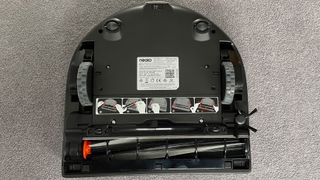
App
- View completed cleans
- Simple scheduling
- Create cleaning and no-go zones
During initial setup, the app guides you through the process and it’s very simple to get the robot connected to your wifi and ready to go. It creates its first map during the first clean, you can name the map and draw no-go zones around areas like pet food bowls.
The robot will create a new map inside the app for each floor of your house. But frustratingly, when we created no-go zones on one floor plan, they were applied to both floor plans of our house and we couldn’t create and save custom no-go zones for each floor. Meaning you’ll have to re-draw no-go zones as you move the vacuum between floors.
Other features available through the app include switching between eco or turbo cleaning modes. You can set up cleaning schedules so the robot will automatically clean on a schedule that suits you and by creating cleaning zones, you can pick different cleaning schedules for different zones of your floorplan. There are also various customizable preferences and alerts including a locate button, which triggers an audio sound on the robot in case you can’t find it.
The app also offers integration with Alexa and Google Assistant so you can use your voice, rather than the app, to start the robot vacuum on a cleaning spree

Battery life
- Returns to charger when battery low
- Boost mode gives shorter run time
- 200 minutes battery life
Neato claims the 200-minute run time is enough to vacuum up to 1600 square feet / 149 square meters but this is based on using the eco mode, so be prepared for shorter run times if you decide to vacuum on turbo. In our tests the D9 vacuumed for 106 minutes on turbo before returning to the charger due to a low battery. At the point it decided it needed a recharge, the battery level was still 15%. Had it run until the battery was almost at 0% it would have had a run time of around 125 minutes in turbo.
It took approximately three and a half hours to recharge to 100% after we let the battery run down to 0%. On top of the robot, you’ll see a battery symbol that changes color depending on the battery level. Yellow means it’s running low and green tells you there’s plenty of run time left. But if in doubt you can also see the exact battery percentage by checking the app.
Should I buy the Neato D9?
Buy it if...
You have mild allergies
The ultra-performance filter captures up to 99.5% of allergens. It’s a better filter than you get with the D8, but serious allergy sufferers should look to the pricier D10 for a true HEPA filter.
Your budget doesn’t stretch to the Neato D10
While it doesn’t quite have the filtration, suction level or battery life of the top-of-the-range D10, the Neato D9 is still a good choice that performs well and offers better features than the entry-level D8.
You want a robot with logical mapping and navigation
The on board lidar allows the robot to map you space, it then approaches the clean in a logical pattern, vacuuming up and down in neat lines so as not to miss a spot.
Don't buy it if..
You have delicate or antique furniture
Although designed to ensure the robot can navigate over high thresholds between floors, this feature means it sometimes tries to climb onto lamp bases or up chair legs, so isn’t advisable for homes with precious antiques or collectables.
You won’t remember to empty the dirt bin
If you’re choosing a robot vacuum because you want to forget about the vacuuming altogether, you’d be better off with a model that features automatic dirt emptying. Otherwise, you’ll still have to empty the dirt bin regularly.
You have pets
Dirt pick up is good, but if you’ve got pets, you need a vacuum that’ll give you the most thorough clean possible. If your budget can stretch to the pricier D10 we’d recommend upgrading for the extra dirt pick up and the option of Max Boost Mode for ultimate performance.
First reviewed: January 2022
- Check out there great robot vacuum deals
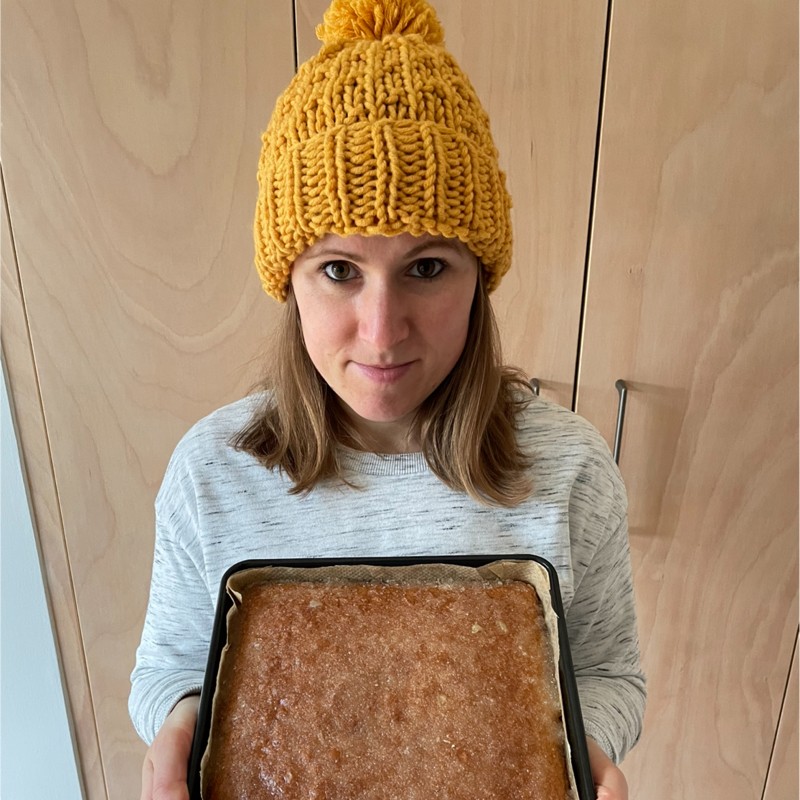
Helen is a freelance writer who specializes in kitchen appliances and has written for some of the biggest home-related titles around. She has been reviewing small appliances, including blenders, juicers, and multi-cookers, for more than 8 years, and also upholsters furniture when she's not testing the latest food tech gadgets.
